|
Where Is It?
Credits
Contact Us
Virtual Tour
Monthly Picture
Birders' Corner
Website Links
|
|
 |
| |
Ridge Wood Birding Diaries
Wednesday 18th March
At last the past few sunny days have given us a tantalising taste of spring, perfect for getting out and exploring the great outdoors, and spotting some birds at the same time! At this time of year, winter visitors to the UK will be preparing to leave, making way for spring / summer arrivals.
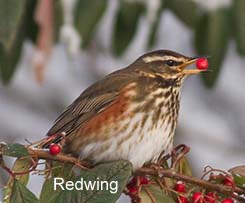
One such winter migrant is the redwing, a large group of which was spotted today on one of the grassy areas leading to the Greenways road entrance of the woodland. Redwings are a type of thrush, similar in size to the song thrush but distinguishable by a pale stripe above the eye and orangey patch on the side. Once here, they spend time in fields and hedgerows, feasting on berries and worms. They tend to be seen in large groups, and plenty have been spotted in the area this winter. Whilst a handful of pairs will stay to breed in the UK, the majority will soon return to their traditional habitat, mainly in Russia.
A stroll along the main woodland path was lovely in the sunshine and revealed many of the wood’s traditional inhabitants including robins, blackbirds, blue-tits and great-tits. A pause by an old dead tree-trunk was rewarded by the sight of a greater spotted woodpecker poking its head out before emerging to fly off to a nearby tree, perhaps in search of a suitable nest-hole site for this year.
Another great sighting from the main path today was of a treecreeper. This little bird, with a body about the size of a wren, is brown and speckled on top and white underneath, with a long, thin beak which curves downwards. As its name suggests, it can be seen working its way up tree trunks, searching for insects and spiders to feed on. Its colouring means it is well camouflaged against the bark, so the best chance of spotting it is by its distinctive pattern of movement. Treecreepers are resident in the UK, mainly in woodlands, and will breed around June time making their nests behind loose bark.
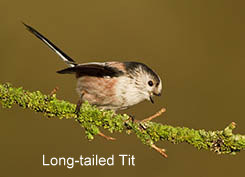
While treecreepers are usually seen on their own, a bird almost always seen in groups is the long-tailed tit. A regular sighting in Ridge Wood, these endearing black and white birds with a hint of pink are often heard before they are seen, recognisable by their high-pitched contact calls. Long-tailed tits have very small bodies next to their long tails, sometimes described as looking like “balls on sticks”! They gather in woodland trees to feed on insects, but will also visit gardens in search of more food in winter. In fact these birds may already have their minds on breeding, as they typically nest much earlier than other tit species, any time from late February, building a dome-shaped nest out of moss and feathers. They typically lay clutches of 6-8 eggs, each weighing less than 1 gram!
So why not get out and enjoy the early spring sunshine? Don’t forget to put the clocks forward next weekend (29th March) – another reminder of the fact that summer will soon be here!
Sunday 25th January 2015
It was lovely to get out and about in the woodland today for our first work morning of the year. Even though it is still early, signs of spring are starting to emerge including primroses starting to push up through the ground as well as a noticeable increase in birdsong.
.jpg) Quite a large number of blackbirds were seen throughout the wood today. Although early in the year, these birds are probably starting to think about establishing territories ready for the important business of finding a mate for the upcoming breeding season. As usual, several robins were spotted perching by the path and singing beautifully. We also spotted a song thrush digging through the undergrowth, presumably searching for worms and insects, making the most of the warmer temperatures this weekend compared with recent weeks. Dunnocks and blue-tits were also easily seen close to the path. Quite a large number of blackbirds were seen throughout the wood today. Although early in the year, these birds are probably starting to think about establishing territories ready for the important business of finding a mate for the upcoming breeding season. As usual, several robins were spotted perching by the path and singing beautifully. We also spotted a song thrush digging through the undergrowth, presumably searching for worms and insects, making the most of the warmer temperatures this weekend compared with recent weeks. Dunnocks and blue-tits were also easily seen close to the path.
Also today it was lovely to spot a jay flying between two trees at the top end of the wood. The most colourful member of the corvid family, the jay can often be recognised before it is seen by its harsh screeching call, and is always a pleasing sight. Also heard but not seen were our resident Great spotted woodpeckers drumming on the trees above.
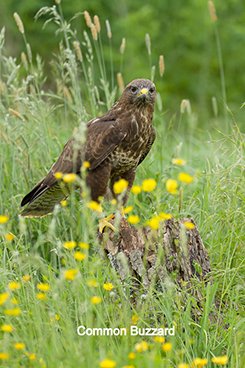 Other recent notable Ridge Wood sightings include a close encounter with a common buzzard. More usually seen circling in the skies up above the wood, last weekend we came across one perched on a tree branch just above the path! Although the buzzard is now Britain’s most common bird of prey it’s still a most impressive sight up close. Buzzards feed on small mammals, birds and carrion, but will also eat earthworms and insects when food is in short supply. Other recent notable Ridge Wood sightings include a close encounter with a common buzzard. More usually seen circling in the skies up above the wood, last weekend we came across one perched on a tree branch just above the path! Although the buzzard is now Britain’s most common bird of prey it’s still a most impressive sight up close. Buzzards feed on small mammals, birds and carrion, but will also eat earthworms and insects when food is in short supply.
Another unusual woodland visitor seen last weekend close to the Quarry Road entrance was a grey wagtail. Grey wagtails are insect feeders which tend to hang around beside river banks looking for their preferred prey such as midges and ants; hence they are frequently to be found along the river Frome at the Chipping Sodbury end of the wood. Although called grey, these charismatic little birds are actually quite colourful with their distinctive yellow bellies. As grey wagtails have been struggling during recent harsh winters it was great to see one out and about and seemingly doing well.
Hopefully the above has inspired you to get out your binoculars and head out into the woods this winter – you never know what you might see!
Thursday 5th June 2014
After a couple of rainy days, finally a perfect evening for a woodland stroll. With the trees now in full leaf it’s a challenging time for birdwatchers, with most birds audible but surprisingly difficult to spot! However with a little patience there were some great species to see.
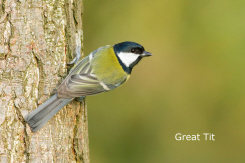 Most of the usual suspects were around, including blackbirds, robins, woodpigeons and blue-tits. And excitingly there was plenty of evidence that the breeding season is in full swing. Both a robin and a great-tit were seen with food in their beaks, hopefully off to feed some hungry chicks. Great tits will usually have just one brood of chicks per year, whereas the robin will usually have two, but may even have four! I then came across a young blackbird, sitting patiently on a branch and calling quietly for its parent (who clearly wasn’t going to return while I was around!). After leaving the nest, it takes blackbird chicks around 3 weeks to become independent, during which time they are looked after by the male parent and (if resident in woodland) fed mainly on caterpillars. Another tree by the path contained a couple of blue-tit fledglings, this time hanging out with their parents in the mid-evening sunshine. Most of the usual suspects were around, including blackbirds, robins, woodpigeons and blue-tits. And excitingly there was plenty of evidence that the breeding season is in full swing. Both a robin and a great-tit were seen with food in their beaks, hopefully off to feed some hungry chicks. Great tits will usually have just one brood of chicks per year, whereas the robin will usually have two, but may even have four! I then came across a young blackbird, sitting patiently on a branch and calling quietly for its parent (who clearly wasn’t going to return while I was around!). After leaving the nest, it takes blackbird chicks around 3 weeks to become independent, during which time they are looked after by the male parent and (if resident in woodland) fed mainly on caterpillars. Another tree by the path contained a couple of blue-tit fledglings, this time hanging out with their parents in the mid-evening sunshine.
Walking up through the woodland the call of a chiff-chaff was clearly heard, but could not be seen tonight; however I did manage to spot a wren flying between some low branches. Also heard were some very noisy jackdaws, and of course the rooks as usual perched up in the rookery.
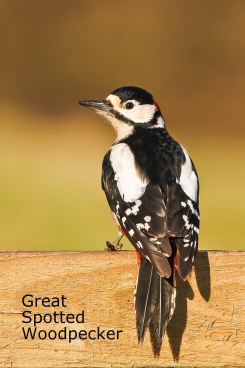 Then, coming back down to the bottom path a real treat – a great spotted woodpecker landed on a tree trunk and began to ascend in front of me! These birds sometimes get a bad press in spring for raiding other species’ nest boxes, but you have to admit they are very handsome. Perhaps the woodpecker may have a nest of its own hidden in a nearby tree – you never know. Happy twitching! Then, coming back down to the bottom path a real treat – a great spotted woodpecker landed on a tree trunk and began to ascend in front of me! These birds sometimes get a bad press in spring for raiding other species’ nest boxes, but you have to admit they are very handsome. Perhaps the woodpecker may have a nest of its own hidden in a nearby tree – you never know. Happy twitching!
Sunday 13th April 2014
It was a beautiful sunny day today – perfect for a walk in the woods. Spring has certainly arrived in the woodland, and it’s looking stunning with carpets of wildflowers including bluebells and wood anemones. And the trees are alive with birdsong!
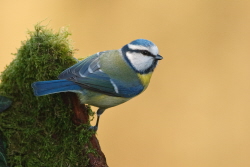 On arrival at the Greenways road entrance to the wood we were greeted by a dunnock, singing away on top of a bush. This little brown bird may be rather plain in appearance but has a beautiful song and is usually seen at some point during every Ridge wood walk. Flitting around in the tree tops around the wood entrance were also a pair of blue-tits, again a very common but equally pleasing sight. On arrival at the Greenways road entrance to the wood we were greeted by a dunnock, singing away on top of a bush. This little brown bird may be rather plain in appearance but has a beautiful song and is usually seen at some point during every Ridge wood walk. Flitting around in the tree tops around the wood entrance were also a pair of blue-tits, again a very common but equally pleasing sight.
Towards the top of the wood today we were fortunate to catch a glimpse of a chiff-chaff, by following its characteristic call. It’s hard to believe that this little bird probably spent the winter in the Mediterranean or even west Africa! Alongside it, calling from a nearby tree was a very handsome song thrush. The other unmistakable sound to be heard at the top of the woodland at the moment comes from the rookery – these noisy birds are currently busy preparing their nests for spring.
Wandering back along the main woodland path an hour later, the sound of a woodpecker could be clearly and repeatedly heard. Greater spotted woodpeckers are a regular sight in the woodland if you are lucky, usually flying in to land on the side of a tree trunk, and many woodland work mornings have been accompanied by the sounds of woodpeckers drumming away on trees. Circling overhead, also readily identified from its call, we saw a buzzard, its wing patterning beautifully clear in the sunshine. Appearing from time to time from some of the lower bushes was a wren – this tiny bird is again a year-round woodland inhabitant. A slightly more unusual sighting this morning was of a male black-cap, which perched very cooperatively on a stick by a patch of bluebells.
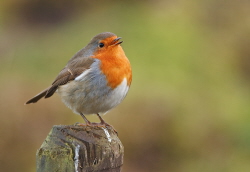 Continuing our walk, we came across some more regular Ridge Wood inhabitants. A group of three blackbirds were seen by the path (two males tolerating each other rather well in the presence of a female), and several woodpigeons were perched in the trees above us. And last but not least, no visit to the wood would be complete without seeing and hearing a robin, which we did on our way back towards the woodland entrance. Continuing our walk, we came across some more regular Ridge Wood inhabitants. A group of three blackbirds were seen by the path (two males tolerating each other rather well in the presence of a female), and several woodpigeons were perched in the trees above us. And last but not least, no visit to the wood would be complete without seeing and hearing a robin, which we did on our way back towards the woodland entrance.
|
|
| |
|